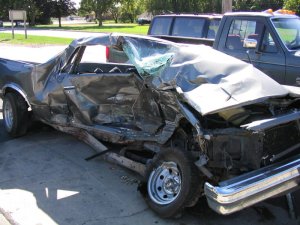Motor Vehicle Accidents: The Leading Cause of Death in Collegiate Athletes
September 20, 2013 1 Comment
The title of today’s post is striking.
In sports medicine we focus–rightly–on entities such as sudden cardiac death, cervical spine injuries, second impact syndrome, exertional heat illness, hyponatremia……There is a long list of conditions that can befall athletes which can cause serious mortality and morbidity.
But from a public health perspective, our priorities are possibly misplaced. At the very least I wonder sometimes if we may ‘strain at a gnat and swallow the camel‘ when we focus intensely on chest protectors and commotio cordis and say nothing about the use of seat belts in our athletes.
In August CJSM published ‘ahead of print’ “Motor Vehicle Accidents: the Leading Cause of Death in Collegiate Athletes,” a study authored by I Asif, K Harmon, and D Klossner, authors who have published other epidemiologic work on sudden death in young athletes. The data presented gave me pause. For all our concern about sudden death from hypertrophic cardiomyopathy, to name one example, the data show that far and away the greatest threat to the young athletes under our care are accidents or unintentional injury.
The authors conducted a 5 year retrospective analysis using two data bases: an NCAA database, and the “Parent Heart Watch” database. This second database has an interesting history: a non profit group which began tracking sudden cardiac death in American athletes in 2000. Various death rates were calculated, notably: 1) an overall death rate for athletes was found to be 13.86/100,000 athlete-years; 2) a death rate from accidents of 7.36/100,000 athlete-years; 3) a death rate from cardiac causes of 2.28/100,000 athlete-years; 4) a death rate due to accidents found highest in the sport of division I wrestlers, with a rate of 28.2/100,000 athlete-years. Deaths from unintentional injuries occur at “….nearly twice the rate of all medical causes of death combined,” the authors note.
I encourage the blog’s readers to go to the study and look closely at the various subanalyses the authors did. There is much to glean about different risk rates in male vs. female athletes, athletes of different sports, athletes of different race.
Risky behavior in college athletes has been looked at in other ways. In 2008 the University of Maine published a study looking at hazing in college students participating in school organizations, including varsity athletics, and found that 74% of varsity athletes had experienced hazing. This practice has gained increased attention here in the United States over the last two years, most especially since the death of a Florida A&M band member from a hazing incident. Another significant threat to college athletes involves their use of alcohol and other substances; the NCAA keeps a database on these practices.
Rather than shrug our collective shoulders and attribute such risks to normative behavior in youth (kids will always drink and drive, get involved with hazing, etc.), the authors of the CJSM study suggest we spend time pondering what interventions we might make to curb these risks. In their discussion they pose the rhetorical question: “Accidents are just accidents: or are they?” They go on to elaborate on evidence that may exist for some interventions, such as the NCAA CHAMPS program. They make the statement that “…sports medicine physicians are in a unique role where they can engage their athletes in discussions about safety, mental health, or violence. For some, these may be the only instances where an athlete encounters a physician during his collegiate years.”
As many of the blog’s readers are, I take care of high school and college athletes in my current practice; I’m a Team Physician for a local high school and university, and tonight, for instance, I’ll be on the sidelines of a football game. Seems like I’ll need to be as concerned about what ‘my’ kids will be doing immediately after the game (driving, partying, etc.) as I will be with what happens on the field.
Anecdotally, the situation the CJSM study presents reminds me of the perceived vs. real risks faced by my peers and me when I was a young Peace Corps Volunteer in Swaziland, Africa. Most of my colleagues who were coming from America for their two year assignments in Africa were worried about contracting malaria, schistosomiasis, amoebic dysentery, or any number of tropical diseases. Who knows, perhaps we may have even been destined to face off with a crocodile! The reality, despite these feverish fantasies? Motor vehicle accidents are the number one cause of death in Peace Corps Volunteers.
Let’s remind our players this weekend to be as smart off the field as on the field.
I look forward to hearing what team physicians out there think about this study and their roles in applying some preventive measures to minimize risky behaviors in their charges.

Pingback: An NFL Owner Wants to Know What YOU Think! | Clinical Journal of Sport Medicine Blog